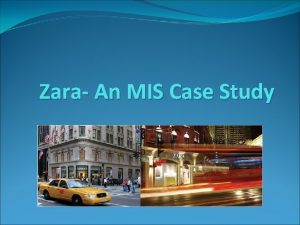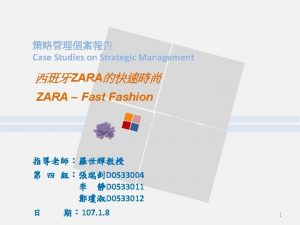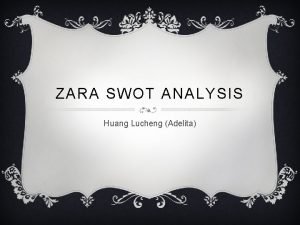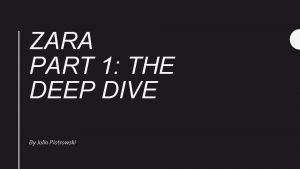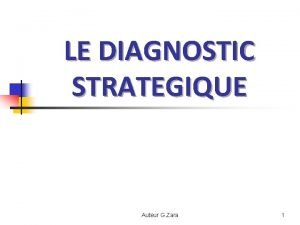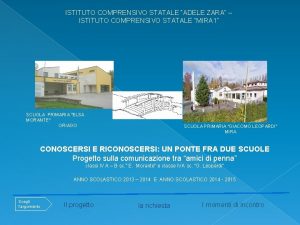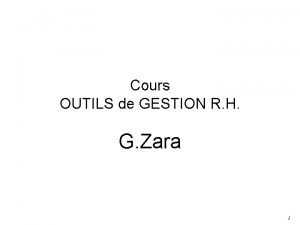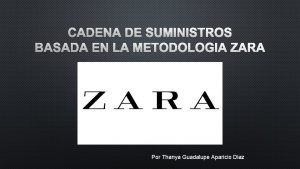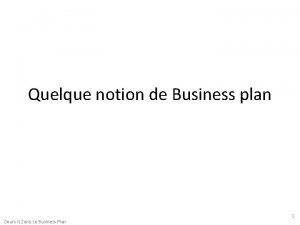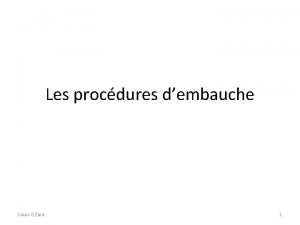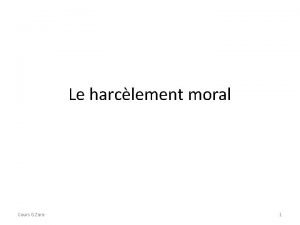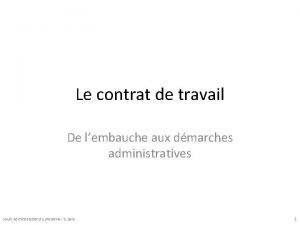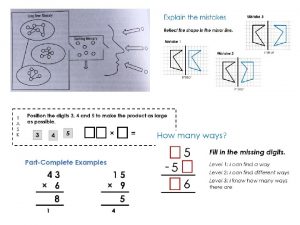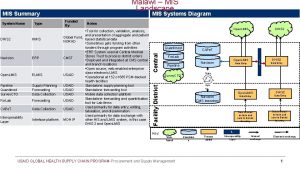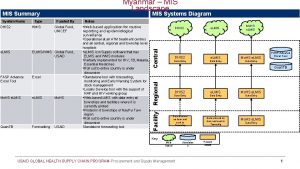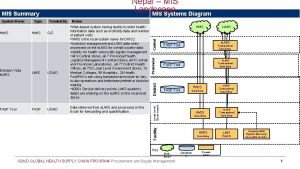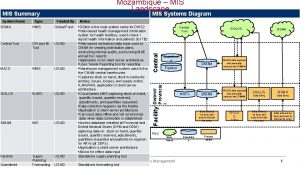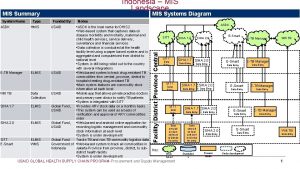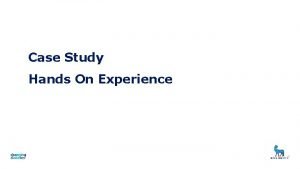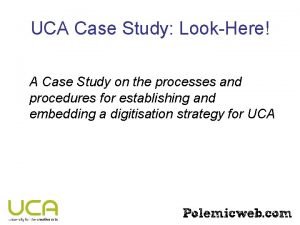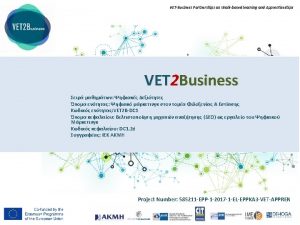Zara An MIS Case Study Using Technology to





























- Slides: 29

Zara- An MIS Case Study

Using Technology to Succeed The poor, ship-building town of La Coruña in northern Spain seems an unlikely home to a tech-charged innovator in the decidedly ungeeky fashion industry That’s where you’ll find “The Cube, ” the gleaming, futuristic central command of the Inditex Corporation, parent of gamechanging clothes giant, Zara. The blend of technology-enabled strategy that Zara has unleashed seems to break all of the rules in the fashion industry. The firm shuns advertising and rarely runs sales. In an industry where nearly every major player outsources manufacturing to low-cost countries, Zara is highly vertically integrated, keeping huge swaths of its production process in-house. These counterintuitive moves are part of a recipe for success that’s beating the pants off the competition, and it has turned the founder of Inditex, Amancio Ortega, into Spain’s wealthiest man and the world’s richest fashion executive.

Amancio Ortega Gaona Forbe’s 10 th riches man in the world - $18. 3 billion Railway worker's son started as a gofer in a shirt store. With then-wife Rosalia Mera, also now a billionaire, started making dressing gowns and lingerie in their living room. Business became one of world's most successful apparel manufacturers. Today Inditex has more than 4, 000 stores in 71 countries. Sales: $12. 3 billion. Ortega is chairman. Has personal investments in gas, tourism, banks and real estate. Owns properties in Madrid, Paris, London, Lisbon, plus a luxury hotel and apartment complex in Miami, a horse-jumping circuit, and an interest in a soccer league. Shuns neckties and fanfare. Daughter Marta works for Inditex; recent speculation suggests she is being groomed to eventually replace her father.

Growth The firm tripled in size between 1996 and 2000 Its earnings skyrocketed from $2. 43 billion in 2001 to $13. 6 billion in 2007. By August 2008, sales edged ahead of Gap, making Inditex the world’s largest fashion retailer While the firm supports eight brands, Zara is unquestionably the firm’s crown jewel and growth engine, accounting for roughly two-thirds of sales.

Zara’s Popularity Zara’s duds look like high fashion but are comparatively inexpensive (average item price is $27, although prices vary by country). A Goldman analyst has described the chain as “Armani at moderate prices, ” while another industry observer suggests that while fashions are more “Banana Republic, ” prices are more “Old Navy. ” Legions of fans eagerly await “Z-day, ” the twiceweekly inventory delivery to each Zara location that brings in the latest clothing lines for women, and children.

What Went Wrong at The Gap Micky Drexler, a man with a radar-accurate sense of style and the iconic CEO who helped turn Gap’s button-down shirts and khakis into America’s business casual uniform, led the way. Drexler’s team had spot-on tastes throughout the 1990 s, but when sales declined in the early part of the following decade, Drexler was left guessing on ways to revitalize the brand, and he guessed wrong—disastrously wrong. The inventory hot potato Drexler was left with crushed the firm. Gap’s same-store sales declined for twenty-nine months straight. Profits vanished. Gap founder and chairman Dan Fisher lamented, “It took us thirty years to get to $1 billion in profits and two years to get to nothing. ” The firm’s debt was downgraded to junk status. Drexler was out and for its new head the board chose Paul Pressler, a Disney executive who ran theme parks and helped rescue the firm’s once ailing retail effort.

Things Got Worse Pressler shut down hundreds of stores, but the hemorrhaging continued largely due to bad bets on colors and styles. During one holiday season, Gap’s clothes were deemed so off target that the firm scrapped its advertising campaign and wrote off much of the inventory. The marketing model used by Gap to draw customers in via bigbudget television promotion had collapsed. Pressler’s tenure saw same-store sales decline in eighteen of twenty-four months. A Fortune article on Pressler’s leadership was titled “Fashion Victim. ” Business. Week described his time as CEO as a “Total System Failure” Wall Street began referring to him as DMW for Dead Man Walking. In January 2007, Pressler resigned, with Gap hoping its third chief executive of the decade could right the ailing giant.

How Does Zara Do It – Store Staff Zara’s store managers lead the intelligence-gathering effort that ultimately determines what ends up on each store’s racks. Armed with personal digital assistants (PDAs) to gather customer input, staff regularly chat up customers to gain feedback on what they’d like to see more of. A Zara manager might casually ask, What if this skirt were in a longer length? Would you like it in a different color? What if this V-neck blouse were available in a round neck? Managers are motivated because as much as 70 percent of salaries can come from commissions.

The Store Staff As soon as the doors close, the staff turns into a sort of investigation unit in the forensics of trend spotting, looking for evidence in the piles of unsold items that customers tried on but didn’t buy. Are there any preferences in cloth, color, or styles offered among the products in stock? PDAs are also linked to the store’s point-of-sale (POS) system that captures customer purchase information. In less than an hour, managers can send updates that combine the hard data captured at the cash register with insights on what customers would like to see. All of this valuable data allows the firm to plan styles and issue rebuy orders based on feedback rather than hunches and guesswork. The goal is to improve the frequency and quality of decisions made by the design and planning teams.

The Designers Data on what sells and what customers want to see goes directly to “The Cube” (central command of the Inditex Corporation outside La Coruña 0), where teams of some three hundred designers crank out an astonishing thirty thousand items a year versus two to four thousand items offered up at big chains like H&M (the world’s third largest fashion retailer) and Gap Individual bonuses are tied to the success of the team, and teams are regularly rotated to cross-pollinate experience and encourage innovation.

Quick Turnaround In the world of fashion, even seemingly well-targeted designs could go out of favor in the months it takes to get plans to contract manufacturers, tool up production, then ship items to warehouses and eventually to retail locations. Zara excels in getting locally targeted designs quickly onto store shelves When Madonna played a set of concerts in Spain, teenage girls arrived to the final show sporting a Zara knock-off of the outfit she wore during her first performance. The average time for a Zara concept to go from idea to appearance in store is fifteen days versus their rivals who receive new styles once or twice a season. Smaller tweaks arrive even faster. Zara is twelve times faster than Gap despite offering roughly ten times more unique products! At H&M, it takes three to five months to go from creation to delivery— and they’re considered one of the best. Other retailers need an average of six months to design a new collection and then another three months to manufacture it. At Zara, most of the products you see in stores didn’t exist three weeks

Quick Turnaround The firm is able to be so responsive through a competitor-crushing combination of vertical integration and technology-orchestrated coordination of suppliers, just-in-time manufacturing, and finely tuned logistics. Vertical integration is when a single firm owns several layers in its value chain A value chain is the set of activities through which a product or service is created and delivered to customers.

Quick Turnaround While H&M has nine hundred suppliers and no factories, nearly 60 percent of Zara’s merchandise is produced in-house, with an eye on leveraging technology in those areas that speed up complex tasks, lower cycle time, and reduce error. Profits from this clothing retailer come from blending math with a data-driven fashion sense. Inventory optimization models help the firm determine how many of which items in which sizes should be delivered to each specific store during twice-weekly shipments, ensuring that each store is stocked with just what it needs. Outside the distribution center in La Coruña, fabric is cut and dyed by robots in twenty-three highly automated factories.

Quick Turnaround Zara makes 40 percent of its own fabric and purchases most of its dyes from its own subsidiary. Roughly half of the cloth arrives undyed so the firm can respond as any midseason fashion shifts occur. After cutting and dying, many items are stitched together through a network of local cooperatives that have worked with Inditex so long they don’t even operate with written contracts. The firm does leverage contract manufacturers (mostly in Turkey and Asia) to produce staple items with longer shelf lives, such as t-shirts and jeans, but such goods account for only about one-eighth of dollar volume.

La Coruña All of the items the firm sells end up in a five-million-square-foot distribution center in La Coruña, or a similar facility in Zaragoza in the northeast of Spain. The La Coruña facility is some nine times the size of Amazon’s warehouse in Fernley, Nevada, or about the size of ninety football fields. The facilities move about two and a half million items every week, with no item staying in-house for more than seventy-two hours. Ceiling-mounted racks and customized sorting machines patterned on equipment used by overnight parcel services, and leveraging Toyotadesigned logistics, whisk items from factories to staging areas for each store. Clothes are ironed in advance and packed on hangers, with security and price tags affixed. This enables employees in Zara stores simply move items from shipping box to store racks, spending most of their time on value-added functions like helping customers find what they want.

Shipping Trucks serve destinations that can be reached overnight, while chartered cargo flights serve farther destinations within forty-eight hours. The firm recently tweaked its shipping models through Air France–KLM Cargo and Emirates Air so flights can coordinate outbound shipment of all Inditex brands with return legs loaded with raw materials and half-finished clothes items from locations outside of Spain. Zara is also a pioneer in going green. In fall 2007, the firm’s CEO unveiled an environmental strategy that includes the use of renewable energy systems at logistics centers including the introduction of biodiesel for the firm’s trucking fleet.

Limited Production Limited runs allow the firm to cultivate the exclusivity of its offerings. While a Gap in Los Angeles carries nearly the same product line as one in Milwaukee, each Zara store is stocked with items tailored to the tastes of its local clientele. A Fifth Avenue shopper quips, “At Gap, everything is the same, ” while a Zara shopper in Madrid says, “you’ll never end up looking like someone else. ” Upon visiting a Zara, the CEO of the National Retail Federation marveled, “It’s like you walk into a new store every two weeks. ”

Limited Production Limited runs encourage customers to buy right away and at full price. Savvy Zara shoppers know the newest items arrive on black plastic hangers, with store staff transferring items to wooden ones later on. Within three weeks, either an item has been sold or moved out to make room for something new. A study by consulting firm Bain & Company estimated that the industry average markdown ratio is approximately 50 percent, while Zara books some 85 percent of its products at full price.

Limited Production The constant parade of new, limited-run items also encourages customers to visit often. The average Zara customer visits the store seventeen times per year, compared with only three annual visits made to competitors. Even more impressive—Zara puts up these numbers with almost no advertising. The firm’s founder has referred to advertising as a “pointless distraction. ” The assertion carries particular weight when you consider that during Gap’s collapse, the firm increased advertising spending but sales dropped. Fashion retailers spend an average of 3. 5 percent of revenue promoting their products, while ad spending at Inditex is just 0. 3 percent.

Limited Production Limited production runs allows the firm to, as Zara’s CEO once put it “reduce to a minimum the risk of making a mistake, and we do make mistakes with our collections. ” Failed product introductions are reported to be just 1%, compared with the industry average of 10%. So even though Zara has higher manufacturing costs than rivals, Inditex gross margins are 56. 8 percent compared to 37. 5 percent at Gap.

Headquarters While stores provide valuable front-line data, headquarters plays a major role in directing in-store operations. Software is used to schedule staff based on each store’s forecasted sales volume, with locations staffing up at peak times such as lunch or early evening. The firm claims these more flexible schedules have shaved staff work hours by 2 percent. This constant refinement of operations throughout the firm’s value chain has helped reverse a prior trend of costs rising faster than sales.

Headquarters Even the store displays are directed from “The Cube, ” where a basement staging area known as “Fashion Street” houses a Potemkin village of bogus storefronts meant to mimic some of the chain’s most exclusive locations throughout the world. It’s here that workers test and fine-tune the chain’s award-winning window displays, merchandise layout, even determine the in-store soundtrack. Every two weeks, new store layout marching orders are forwarded to managers at each location.

Challenges Limitations of Zara’s Spain-centric, just-in-time manufacturing model. By moving all of the firm’s deliveries through just two locations, both in Spain, the firm remains hostage to anything that could create a disruption in the region. Firms often hedge risks that could shut down operations—think weather, natural disaster, terrorism, labor strife, or political unrest—by spreading facilities throughout the globe. If problems occur in northern Spain, Zara has no such fall back.

Challenges The firm is potentially more susceptible to financial vulnerabilities as the Euro has strengthened relative to the dollar. Zara’s Spain-centric costs rise at higher rates compared to competitors, presenting a challenge in keeping profit margins in check. Rising transportation costs are another concern. If fuel costs rise, the model of twice-weekly deliveries that has been key to defining the Zara experience becomes more expensive to maintain. Zara is able to make up for some cost increases by raising prices overseas In the United States, Zara items can cost 40 percent or more than they do in Spain. Zara reports that all North American stores are profitable, and that it can continue to grow its presence, serving forty to fifty stores with just two U. S. jet flights a week.

The Competition Rivals have studied the firm’s secret recipe, and while none have attained the efficiency of Zara, many are trying to learn from the master. There is precedent for contract firms closing the cycle time gap with vertically integrated competitors that own their own factories. Dell (a firm that builds its own PCs while nearly all its competitors use contract labor) has recently seen its manufacturing advantage from vertical integration fall as the partners that supply rivals have mimicked its techniques and have become far more efficient. H&M has increased the frequency of new items in stores, Forever 21 and Uniqlo get new looks within six weeks, Renner, a Brazilian fast fashion rival, rolls out mini collections every two months, and Benetton, a firm that previously closed some 90 percent of U. S. stores, now replenishes stores as fast as once a week.

Broader Economic Conditions When the economy falters, consumers simply buy less and may move a greater share of their wallet to lessstylish and lower-cost offerings from deep discounters like Wal-Mart. Zara is particularly susceptible to conditions in Spain, since the market accounts for nearly 40 percent of Inditex sales, as well as to broader West European conditions (which with Spain make up 79 percent of sales). Global expansion will provide the firm with a mix of locations that may be better able to endure downturns in any single region.

The Importance of MIS & IT Zara’s winning formula can only exist through management’s savvy understanding of how information systems can enable winning strategies Many tech initiatives were led by José Maria Castellano, a “technophile” business professor who became Ortega’s righthand man in the 1980 s). It is technology that helps Zara identify and manufacture the clothes customers want, get those products to market quickly, and eliminate costs related to advertising, inventory missteps, and markdowns. A strategist must always scan the state of the market as well as the state of the art in technology, looking for new opportunities and remaining aware of impending threats.

Inditex – 1 Year Trend

Inditex – 5 Year Trend
 Zara management information system
Zara management information system Zara strategic management
Zara strategic management Management information system case study
Management information system case study Best case worst case average case
Best case worst case average case It project failure case study
It project failure case study Mision del proyecto de vida
Mision del proyecto de vida Los hijos de mi tío son mis
Los hijos de mi tío son mis Mis mai a mis tachwedd
Mis mai a mis tachwedd Mis mai a mis tachwedd
Mis mai a mis tachwedd Mis actos son un reflejo de mis creencias
Mis actos son un reflejo de mis creencias Report
Report Mis chapter 6
Mis chapter 6 David m kroenke using mis
David m kroenke using mis Zara swot analysis
Zara swot analysis Zara indirect competitors
Zara indirect competitors Scm zara
Scm zara Diagnostic stratégique externe
Diagnostic stratégique externe Ic volpago
Ic volpago Istituto adele zara
Istituto adele zara Creo en dios padre letra
Creo en dios padre letra Marketing mix de zara
Marketing mix de zara Tableau diagnostic rh
Tableau diagnostic rh Cadena de abastecimiento de zara
Cadena de abastecimiento de zara Zara it
Zara it We are group
We are group Business plan zara
Business plan zara Zara demitrova
Zara demitrova Entretien d'embauche zara
Entretien d'embauche zara Zara grance
Zara grance Zara cotisation urssaf
Zara cotisation urssaf
